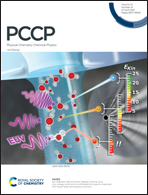Theoretical calculation assisted materials screening of BiOX (X = F, Cl, Br, I) for electrochemical absorption of cesium ions†
Abstract
The electrochemical switching ion exchange (ESIX) technique has been widely used for the separation and recovery of radioactive cesium ions (Cs+) from wastewater. In this study, a series of BiOX (X = F, Cl, Br, I) materials were first evaluated for their absorption properties to Cs+ through density functional theory (DFT) calculations. The calculations predict that BiOBr has the best absorption performance among the four materials, BiOF, BiOCl, BiOBr, and BiOI, due to its high absorption energy and low ion migration energy barrier to Cs+. Simultaneously, the selectivity calculations revealed that BiOBr also showed the best selectivity for Cs+ compared with Li+ and Na+. Subsequently, four materials were prepared using the hydrothermal synthesis method and their electrochemical absorption performance was tested. The results showed that BiOBr has the highest electroactivity, and its absorption capacity was up to 16 mg Cs+/g BiOBr in a solution mixture of 50 ppm Li+, Na+, and Cs+. Based on our theoretical calculations and experiments, our findings provide prospective insights for predicting the electrochemical absorption performance of materials using first-principles calculations.



 Please wait while we load your content...
Please wait while we load your content...